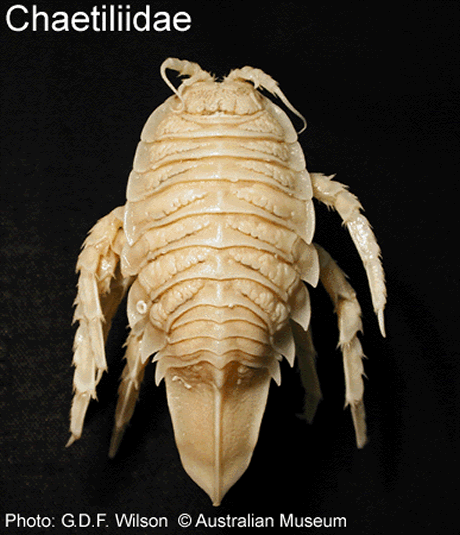 |
||||||
|
|
|
|
|
|
Australian Isopoda: FamiliesS.J. Keable, G.C.B. Poore & G.D.F. WilsonChaetiliidae Dana, 1849 Chaetilinae Dana, 1849: 427. Chaetiliidae. -Poore, 2001b: 219. Description. Body. Body shape without loss or gross modification of appendages on one side of the body; in dorsal view without peduncular articles of antenna 1 or 2 contiguous with coxal margins, tapering posteriorly; in lateral view straight, more or less flattened or semicylindrical, or strongly vaulted. Body surface smooth or slightly sculptured, or variously spinose or rugose. Head. Head not capable of lateral rotation (laterally encompassed, abutting or fused to pereonite 1); free from pereonite 1; with prominent flat lateral lobes, sometimes with ocular notch. Eyes reduced or lost. Antenna 1 inserting on head anteriorly and/or dorsally to antenna 2, minute or well developed; not as follows: reduced to 2 articles with second article expanded and scalloped. Antenna 2 well developed; flagellum multiarticulate (sometimes of few articles). Mouthparts not forming suctorial cone or proboscis. Mandible not projecting anteriorly and together forceps-like; palp absent. Maxilliped epipod shorter than wide. Pereon. Pereonite 4 of similar length to pereonite 3. Pereonites 6-7 pereonite 7 distinct dorsally, free. Coxae extending ventrally and laterally to overhang the coxa-basis articulation of the pereopods; 2-7 more or less ventrally expanded over bases of pereopods, or 5-7 expanded over bases of pereopods and tergites marginal on pereonites 2-4. Oostegites 1-5 functional (as far as known). Pereopods 6-7 pairs readily apparent; 1-3 or 1-7 not prehensile; differentiated, 1, 1-3, 1-5 or 1-6 subchelate; without dense fur of fine setae in males. Pereopods 2-4 with irregular fine setae and marginal robust setae. Pereopods 5-7 without flattened setose articles andor dactyls modified or absent. Penes paired, widely separate (sometimes obsolete). Pleon / Pleotelson. Pleonites and pleotelson with pleonite 5 and pleotelson fused, pleonites 1-4 articulating, or pleonites 4-5 and pleotelson fused, pleonites 1-3 articulating, or pleonites 3-5 and pleotelson fused, pleonites 1-2 articulating (other pleonites sometimes indicated laterally or dorsally). Pleopods 5 pairs present. Pleopod 1 peduncle subequal to peduncle on pleopods 2-5; marginal setae on rami longer than, or equal to, length of rami; exopod of males laminar, lateral excavation absent. Pleopod 2 of males not consisting of an enlarged peduncle with a geniculate endopod and a small muscular exopod; appendix masculina twice length of endopod, basally less than half width of endopod. Uropods positioned proximally on pleotelson; folded ventrally below pleotelson, forming operculum enclosing pleopodal chamber. Peduncle not forming an elongate clavate article with rami reduced or absent. Endopod not claw-like (acute and recurved) andor posteroventral in position. Exopod not folded dorsally over pleotelson, ovate, fringed with setae, more than half as long as endopod. Distribution and generic composition. See Kensley et al. (1996), note that Proidotea is a fossil taxon.
Cite this publication as: 'S.J. Keable, G.C.B. Poore & G.D.F. Wilson (2002 onwards). 'Australian Isopoda: Families. Version: 2 October 2002. https://crustacea.net'. |
|
|
|
|
|
|
|
|
|
Copyright © Australian Museum, 2002 - 2003
Australian Museum website


